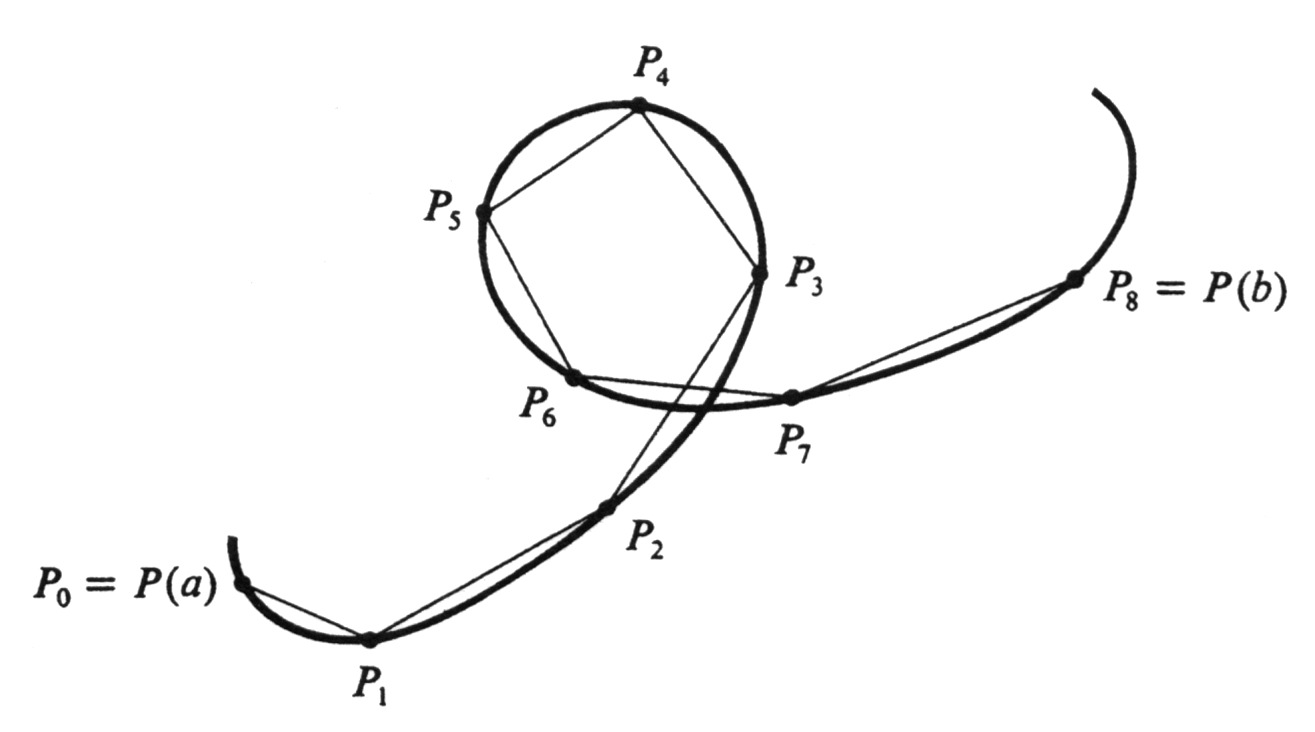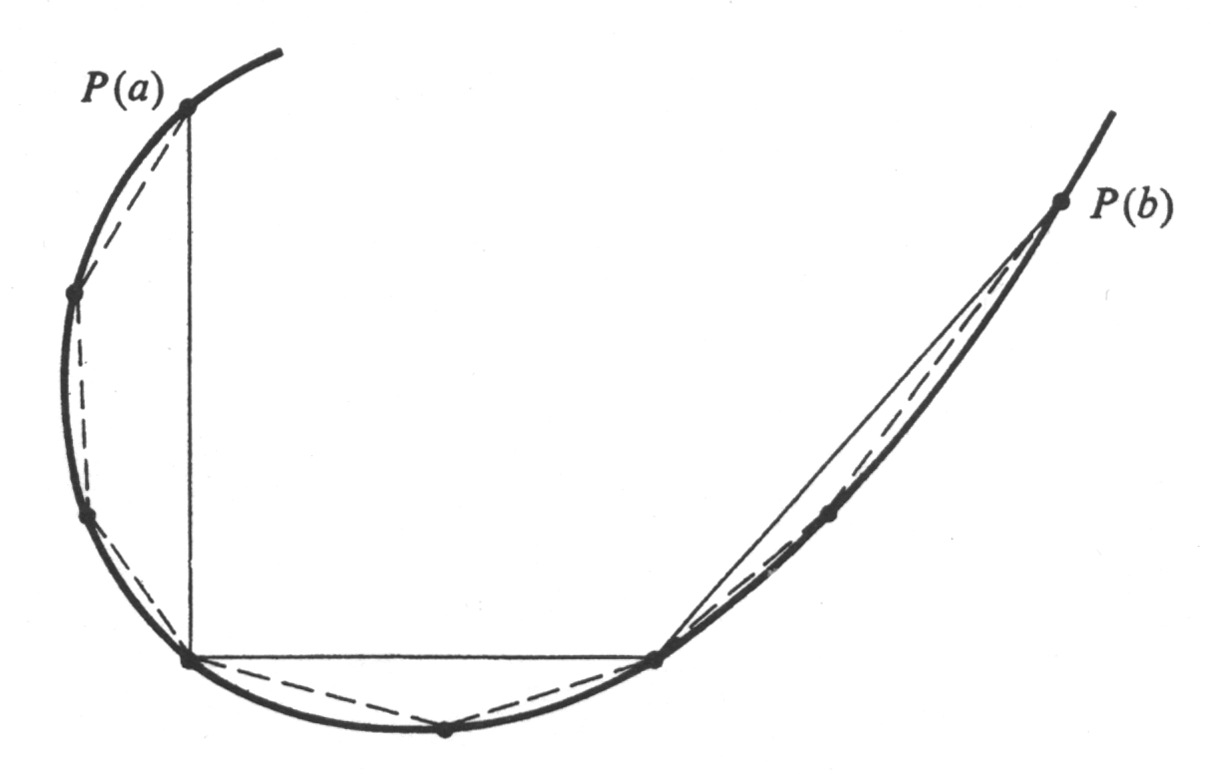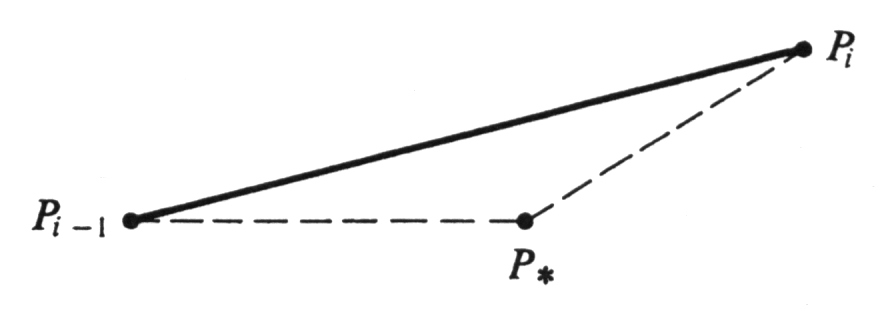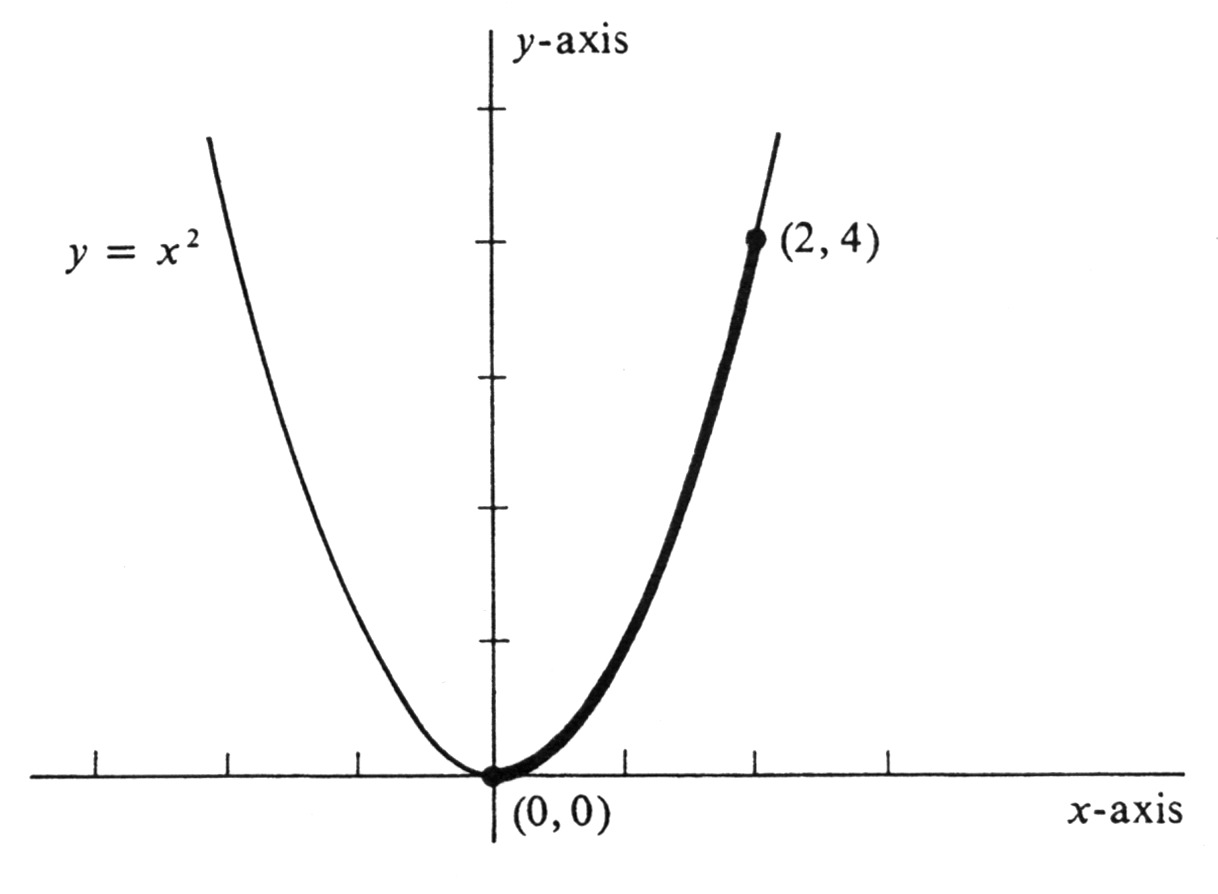guide:352d094fa1: Difference between revisions
No edit summary |
mNo edit summary |
||
| (One intermediate revision by the same user not shown) | |||
| Line 32: | Line 32: | ||
\newcommand{\mathds}{\mathbb} | \newcommand{\mathds}{\mathbb} | ||
</math></div> | </math></div> | ||
The straight-line distance in the plane between two points <math>P = (x_1, y_1)</math> and <math>Q = (x_2, y_2)</math> is defined in Section 2 of Chapter 1 by the formula | The straight-line distance in the plane between two points <math>P = (x_1, y_1)</math> and <math>Q = (x_2, y_2)</math> is defined in Section 2 of Chapter 1 by the formula | ||
| Line 47: | Line 47: | ||
<math display="block"> | <math display="block"> | ||
P(t) = (x(t), y(t)), \;\;\;\mbox{for every $t$ in | P(t) = (x(t), y(t)), \;\;\;\mbox{for every $t$ in $I$.} | ||
</math> | </math> | ||
Consider a partition <math>\sigma = \{ t_0, . . . , t_n \}</math> of the closed interval <math>[a, b]</math> such that | Consider a partition <math>\sigma = \{ t_0, . . . , t_n \}</math> of the closed interval <math>[a, b]</math> such that | ||
| Line 69: | Line 69: | ||
L_\sigma = \sum_{i=1}^n \sqrt{[x(t_i) - x(t_{i-1})]^2 + [y(t_i) - y(t_{i-1})]^2} . | L_\sigma = \sum_{i=1}^n \sqrt{[x(t_i) - x(t_{i-1})]^2 + [y(t_i) - y(t_{i-1})]^2} . | ||
</math> | </math> | ||
<div id="fig 10.6" class="d-flex justify-content-center"> | <div id="fig 10.6" class="d-flex justify-content-center"> | ||
[[File:guide_c5467_scanfig10_6.png | 400px | thumb | ]] | [[File:guide_c5467_scanfig10_6.png | 400px | thumb | ]] | ||
| Line 354: | Line 354: | ||
</math> | </math> | ||
==General references== | ==General references== | ||
{{cite web |title=Crowell and Slesnick’s Calculus with Analytic Geometry|url=https://math.dartmouth.edu/~doyle/docs/calc/calc.pdf |last=Doyle |first=Peter G.|date=2008 |access-date=Oct 29, 2024}} | {{cite web |title=Crowell and Slesnick’s Calculus with Analytic Geometry|url=https://math.dartmouth.edu/~doyle/docs/calc/calc.pdf |last=Doyle |first=Peter G.|date=2008 |access-date=Oct 29, 2024}} | ||
Latest revision as of 01:21, 21 November 2024
The straight-line distance in the plane between two points [math]P = (x_1, y_1)[/math] and [math]Q = (x_2, y_2)[/math] is defined in Section 2 of Chapter 1 by the formula
In this section we shall consider the harder problem of defining distance, or arc length, along a parametrized curve. Let [math]C[/math] be a curve parametrically defined by a continuous function [math]P: I \rightarrow R^2[/math], and let [math]a[/math] and [math]b[/math] be two numbers in the interval [math]I[/math] such that [math]a \lt b[/math]. As we have seen in Section \secref{10.1}, [math]C[/math] is the set of all points
Consider a partition [math]\sigma = \{ t_0, . . . , t_n \}[/math] of the closed interval [math][a, b][/math] such that
and set [math]P(t_i) = P_i[/math], for every [math]i = 0, . . ., n[/math]. We shall take the number [math]L_\sigma[/math] defined by
as an approximation to the arc length along [math]C[/math] from [math]P(a)[/math] to [math]P(b)[/math]. In Figure 6, the number [math]L_\sigma[/math] is the sum of the lengths of the straight-line segments joining the points along the curve. Using (1), we may also write
The principle which motivates the definition of arc length is the fact that if one partition [math]\sigma[/math] of [math][a, b][/math] is a subset of another partition [math]\tau[/math], then [math]L_\tau[/math] is in general a better approximation than [math]L_\sigma[/math]. The basic reason for this is simply that the finer partition [math]\tau[/math] determines more points on the curve. As an example, consider Figure 7, in which [math]L_\sigma[/math] is the sum of the lengths of the solid straightline segments, and [math]L_\tau[/math] is the sum of the lengths of the dashed-line segments. It is clear from the picture that [math]L_\tau[/math] is closer than [math]L_\sigma[/math] to our intuitive idea of the arc length of the curve. Moreover,
If one partition [math]\sigma[/math] of [math][a, b][/math] is a subset of another [math]\tau[/math], then [math]L_\sigma \leq L_\tau[/math].
This fact is geometrically apparent from Figure 7. The argument can be reduced to consideration of a single triangle by the realization that, since [math]\tau[/math] can be obtained from [math]\sigma[/math] by adjoining one new point at a time, it will be sufficient to prove the result under the assumption that [math]\tau[/math] differs from [math]\sigma[/math] by the inclusion of only one additional point, which we denote by [math]t_{*}[/math]. Let [math]P_{*} = P(t_{*})[/math]. For some integer [math]i[/math], we have [math]t_{i-1} \lt t_{*} \lt t_i[/math]. Then the expressions for [math]L_\sigma[/math] and [math]L_\tau[/math] are obviously the same except that the term [math]distance(P_{i-1}, P_i)[/math], in [math]L_\sigma[/math] is replaced by the sum [math]distance(P_{i-1}, P_{*}) + distance(P_{*}, P_i)[/math] in [math]L_\tau[/math]. Hence
Thus partitions with more points result in approximations at least as large. This brings us to the definition of arc length: Let [math]C[/math] be a curve parametrized by a continuous function [math]P: I \rightarrow R^2[/math], and let [math]a[/math] and [math]b[/math] be two numbers in [math]I[/math] with [math]a \leq b[/math]. We consider the set of all real numbers [math]L_\sigma[/math] formed from all partitions [math]\sigma[/math] of the interval [math][a, b][/math]. This set, denoted by [math]\{ L_\sigma \}[/math], either has an upper bound or it does not. The arc length of the parametrized curve [math]C[/math] from [math]P(a)[/math] to [math]P(b)[/math] will be denoted by [math]L_a^b[/math] and is defined by
A curve parametrized by a continuous function [math]P:[a, b] \rightarrow R^2[/math] is said to be rectifiable if its arc length [math]L_a^b[/math] is finite. The main difficulty with the above definition, like that of the definite integral, is that it is by no means immediately apparent how to use it to compute the arc lengths of even very simple rectifiable curves. We shall now show that if the parametrization satisfies a simple differentiability condition, then the arc length is given by a definite integral.
THEOREM. Consider a parametrization defined by [math]P(t) = (x(t), y(t))[/math], for every [math]t[/math] in an interval [math][a, b][/math]. If the derivatives [math]x'[/math] and [math]y'[/math] are continuous functions, then the curve [math]C[/math] parametrized by [math]P[/math] is rectifiable and its arc length is given by
(Note that we have used [math]x'(t)^2[/math] for [math][x'(t)]^2[/math] and [math]y'(t)^2[/math] for [math][y'(t)]^2[/math]. This is a common abbreviation, which we shall not hesitate to use whenever it causes no ambiguity.)
If [math]a = b[/math], then [math]L_a^b[/math] is certainly equal to zero, as is the integral; so we assume that [math]a \lt b[/math]. Let [math]\sigma = \{ t_0, . . ., t_n \}[/math] be a partition of [math][a, b][/math] with
Example
Compute the arc length of the curve [math]C[/math] defined parametrically by [math]P(t) = (x(t), y(t))[/math], where
between [math]P(0) = (0, 0)[/math] and [math]P(2\pi) = (2\pi a, 0)[/math]. The curve [math]C[/math] is the cycloid discussed at the end of Section \secref{10.1} and illustrated in Figure 4. We have
These are obviously continuous functions, and the arc length is therefore given by the integral formula. We obtain
However, we have the trigonometric identities
from which it follows that
Hence
Since [math]\sin \frac{t}{2}[/math] is nonnegative for every [math]t[/math] in the interval [math][0, 2\pi][/math], we conclude that
Thus the arc length [math]L = L_0^{2\pi}[/math] is given by
Suppose that a curve is given as the graph of a continuously differentiable function. In more detail: Let the derivative [math]f'[/math] of a function [math]f[/math] be continuous at every [math]x[/math] in some interval [math][a, b][/math]. The graph of the equation [math]y = f(x)[/math] is a curve which can be parametrically defined by
Then [math]x'(t) = 1[/math] and [math]y'(t) = f'(t)[/math]. Since [math]x'[/math] is a constant function, it is certainly continuous. Since [math]f'[/math] is by assumption continuous on [math][a, b][/math] and since [math]y' = f'[/math], the function [math]y'[/math] is also continuous. Hence the arc length [math]L_a^b[/math] is given by
The variable of integration which appears in a definite integral is a dummy variable (see page 171), and we may therefore replace [math]t[/math] by [math]x[/math] in the right integral. Thus, we have proved, as a corollary of Theorem (2.2),
If the derivative of a function [math]f[/math] is continuous at every [math]x[/math] in an interval [math][a, b][/math], then the graph of [math]y = f(x)[/math] is a rectifiable curve and its arc length [math]L_a^b[/math] is given by
Example
Find the arc length [math]L[/math] of the graph of the equation [math]y = x^2[/math] from the point (0, 0) to the point (2, 4). The curve is the familiar parabola shown in Figure 9. Using the result of the preceding theorem, we have
Since [math]\frac{dy}{dx} = 2x[/math],
This integral can be evaluated by means of the trigonometric substitution [math]x = \frac{1}{2} \tan \theta[/math], or, equivalently, [math]2x = \tan \theta[/math]. If [math]x = 0[/math], then [math] \theta = 0[/math], and, similarly, if [math]x = 2[/math], then [math] \theta = \arctan 4[/math]. For convenience we shall set [math]\arctan 4 = \theta_0[/math]. The substitution yields [math] \sqrt{1 + 4x^2} = \sqrt{1 + \tan^2 \theta} = \sec \theta[/math], and [math]dx = \frac{1}{2} \sec^2 \theta d \theta[/math]. Hence using the Change of Variable Theorem for Definite Integrals, we obtain
The reduction formula on page 369 gives
and also on page 369 we have
It follows that
Since [math]\theta_0 = \arctan 4[/math], we have [math]\tan \theta_0 = 4[/math] and [math]\sec \theta_0 = \sqrt{1 + \tan^2 \theta_0} = \sqrt{17}[/math]. Hence the arc length [math]L[/math] is equal to
General references
Doyle, Peter G. (2008). "Crowell and Slesnick's Calculus with Analytic Geometry" (PDF). Retrieved Oct 29, 2024.



